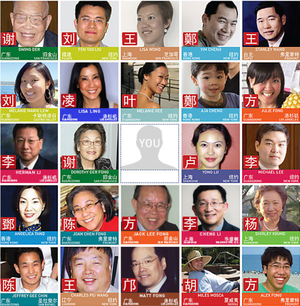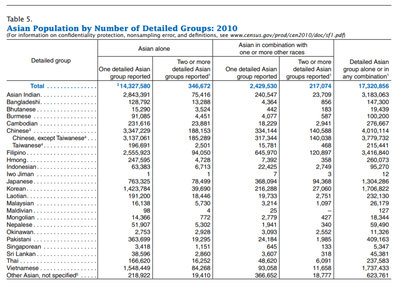Chinese American | 华裔美国人
|
Professor Frank Wu: The New Chinese Diaspora - Embracing the Model Minority and Perpetual Foreigner?
Professor Xiaoyan Zhang: "American Democracy in the Eyes of a New Immigrant from China" 
Who is a Chinese American? What is the Chinese American population? These questions may appear simple on the surface, but they are subject to definitions and interpretations. They have also evolved over time.
For data collection purposes, the Office of Management and Budget is the official authority to define racial and ethnic categories for the United States. Today, Chinese American is a sub-category of Asian American, defined as "A person having origins in any of the original peoples of the Far East, Southeast Asia, or the Indian subcontinent including, for example, Cambodia, China, India, Japan, Korea, Malaysia, Pakistan, the Philippine Islands, Thailand, and Vietnam." This government definition generally reflects a recognized social definition. It is not an attempt to define race biologically, anthropologically, or genetically, nor is it linked to the standard geographical definitions. In practice, an individual associates his or her race and ethnicity by self-identification. The U.S. Census Bureau produces official statistics on the Chinese American population according to this definition and self-identified data, which include U.S. citizens and nationals, as well as permanent residents. Under this definition and interpretation, a Chinese American may also be described as a Chinese in America. Definition used in social, legal and other applications may vary, such as the requirement of U.S. citizenship. Basic Statistics The first recorded arrival of three Chinese sailors in the U.S. travelled from Canton (now Guangzhou), China on board the ship Pallas to Baltimore, Maryland in August 1785. The first recorded Chinese immigrants arrived in the U.S. around 1820. By 1860, the census counted 34,933 Chinese living in California. More than three quarters of them were miners and laborers who first came to the U.S. during the 1848-1855 Gold Rush and then helped built and completed the First Transcontinental Railroad by 1869. The 2010 census showed that the Asian population grew faster than any other race group over the previous decade. Chinese Americans was the largest detailed Asian group, with about 3.3 million people reporting Chinese alone and an additional 700,000 people identifying as both Chinese and one or more additional detailed Asian groups and/or another race. According to the 2017 American Community Survey, the Census Bureau estimated a population of Chinese Americans of one or more races to be slightly over 5 million, or about 1.5% of the total U.S. population. Additional statistics on Chinese in America are available from, for example, the Census Bureau, the Migration Policy Institute, and the Pew Research Center. Beyond Statistics Beyond these statistics, the Chinese American population is complex as it has evolved over the past two hundred years. Several waves of immigrations have occurred; they were also severely repressed for more than 60 years under the Chinese Exclusion Act. There are American-born Chinese (ABC) whose roots have been here for generations; there are also recent naturalized citizens and immigrants of diverse economic and educational background who came from Hong Kong, Taiwan, China and the rest of the world. Not surprisingly, more in-depth understanding about the Chinese American population varies according to perspectives, experiences, and even aspirations, notably between ABCs and more recent naturalized citizens and immigrants. Two prominent Chinese American leaders of such diverse background, who have long been engaged with APA Justice, offer their views on this topic. They are:
|

谁是华裔美国人? 华裔美国人口是多少? 从表面上看,这些问题可能看似简单,但它们需要定义和解释。 它们也随着时间而変更。 出于数据收集的目的,管理和预算办公室是为美国界定种族和族裔类别的官方机构。 今天,华裔美国人是亚裔美国人的子类别,亚裔美国人被定义为“起源于远东,东南亚或印度次大陆的任何原始民族的人,例如柬埔寨,中国,印度 ,日本,韩国,马来西亚,巴基斯坦,菲律宾,泰国和越南。“ 这个政府定义通常反映了普遍公认的社会定义。 它不反映生物学,人类学或遗传学的定义想法,也不是与标准地理定义相关联的。 在实践中,各人根据定义自我选择认同个人的种族。 美国人口普查局根据这一定义和自我识别的数据提供有关华裔美国人口的官方统计数据,其中包括美国公民、国民以及永久居民。 根据这一定义和解释,华裔美国人在美国也可能被描述为在美华人或美国华裔。用于社会、法律或其他用途的定义会有差異,例如需要公民身份。 基本统计 1785年8月,三名中国水手在美国首次登陆,从中国广州乘帕拉斯船到马里兰州的巴尔的摩。第一批有记录的中国移民于1820年左右抵达美国。 到1860年,人口普查统计报告共有34,933名华人居住在加利福尼亚州。 其中四分之三以上是矿工和劳工,他们在1848-1855淘金热期间首次来到美国,然后在1869年帮助建造并完成了第一条横贯大陆的铁路。 2010年人口普查显示,在过去十年中,亚裔人口增长速度超过任何其他种族群体。 华裔美国人是亚裔美国人中最大的群体,共有330万自报是华人,还有70万人自报是华人和其他种族混合。 根据2017年美国社区调查,人口普查局估计,自报是华人或多个种族的华裔美国人口略多于500万,约占美国总人口的1.5%。 更多有关华裔美国人的统计数据可見于例如,普查局,移民政策研究所和皮尤研究中心。 统计以外 这些统计数据之外,华裔美国人口在过去两百年里一直有复杂的变化。 既有几波移民潮; 亦被60多年的《排华法案》严重压制。 有美国出生的华人(ABC),其根源已经存在了好几代人; 还有最近来自香港,台湾,中国和世界其他地区具有不同经济和教育背景的入籍公民和移民。 根据各方观点、经验甚至愿望,对华裔美国人口更深入了解而产生的差异,毫不为怪,特别是在ABCs、入籍的公民和最近移民之间的看法。 长期与APA Justice合作的两位具有多元背景的美国华裔领导人就此话题提出了自己的看法。他们是:
|
|
China's Policy:
Huaren or Huaqiao
2019/10/07 South China Morning Post opinion: Huaren or huaqiao? Beijing respects the difference and is not coercing foreigners to toe its line 2019 No/ 14 ISEAS – Yusof Ishak Institute: China’s Evolving Policy Towards The Chinese Diaspora in Southeast Asia (1949–2018) |
U.S. Policy:
Nationality, Citizenship, and U.S. Persons U.S. State Department on Dual Nationality and Citizenship:
For data collection and national security purposes, a "U.S. person" includes citizens, lawfully admitted permanent resident aliens, and corporations incorporated in the United States. See U.S. Code § 1801 (i): https://www.law.cornell.edu/uscode/text/50/1801 |